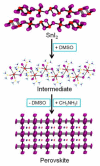A Review on the Progress, Challenges, and Performances of Tin-Based Perovskite Solar Cells
- PMID: 36770546
- PMCID: PMC9920041
- DOI: 10.3390/nano13030585
A Review on the Progress, Challenges, and Performances of Tin-Based Perovskite Solar Cells
Abstract
In this twenty-first century, energy shortages have become a global issue as energy demand is growing at an astounding rate while the energy supply from fossil fuels is depleting. Thus, the urge to develop sustainable renewable energy to replace fossil fuels is significant to prevent energy shortages. Solar energy is the most promising, accessible, renewable, clean, and sustainable substitute for fossil fuels. Third-generation (3G) emerging solar cell technologies have been popular in the research field as there are many possibilities to be explored. Among the 3G solar cell technologies, perovskite solar cells (PSCs) are the most rapidly developing technology, making them suitable for generating electricity efficiently with low production costs. However, the toxicity of Pb in organic-inorganic metal halide PSCs has inherent shortcomings, which will lead to environmental contamination and public health problems. Therefore, developing a lead-free perovskite solar cell is necessary to ensure human health and a pollution-free environment. This review paper summarized numerous types of Sn-based perovskites with important achievements in experimental-based studies to date.
Keywords: 3G solar cell technologies; Sn-based perovskite solar cells; lead-free perovskite solar cells.
Conflict of interest statement
The authors declare no conflict of interest.
Figures






References
-
- Yang X.-Y. Photoenergy and Thin Film Materials. John Wiley & Sons; New York, NY, USA: 2019. Google Books.
-
- Ren Y., Liu X., Li H., Qin J., Du S., Lu X., Tong J., Yang C., Li J. Utilizing Non-Conjugated Small-Molecular Tetrasodium Iminodisuccinateas Electron Transport Layer Enabled Improving Efficiency of Organic Solar Cells. Opt. Mater. 2022;129:112520. doi: 10.1016/j.optmat.2022.112520. - DOI
-
- Zeng L., Wang L., Qin J., Ren Y., Li H., Lu X., Lu F., Tong J., Li J. Applying L-Cystine as an Electron Transport Layer toward Efficient Organic Solar Cells. Opt. Mater. 2023;136:113404. doi: 10.1016/j.optmat.2022.113404. - DOI
-
- Kim H.-S., Im S.H., Park N.-G. Organolead Halide Perovskite: New Horizons in Solar Cell Research. J. Phys. Chem. C. 2014;118:5615–5625. doi: 10.1021/jp409025w. - DOI
-
- Tonui P., Oseni S.O., Sharma G., Yan Q., Tessema Mola G. Perovskites Photovoltaic Solar Cells: An Overview of Current Status. Renew. Sustain. Energy Rev. 2018;91:1025–1044. doi: 10.1016/j.rser.2018.04.069. - DOI
Publication types
Grants and funding
LinkOut - more resources
Full Text Sources

